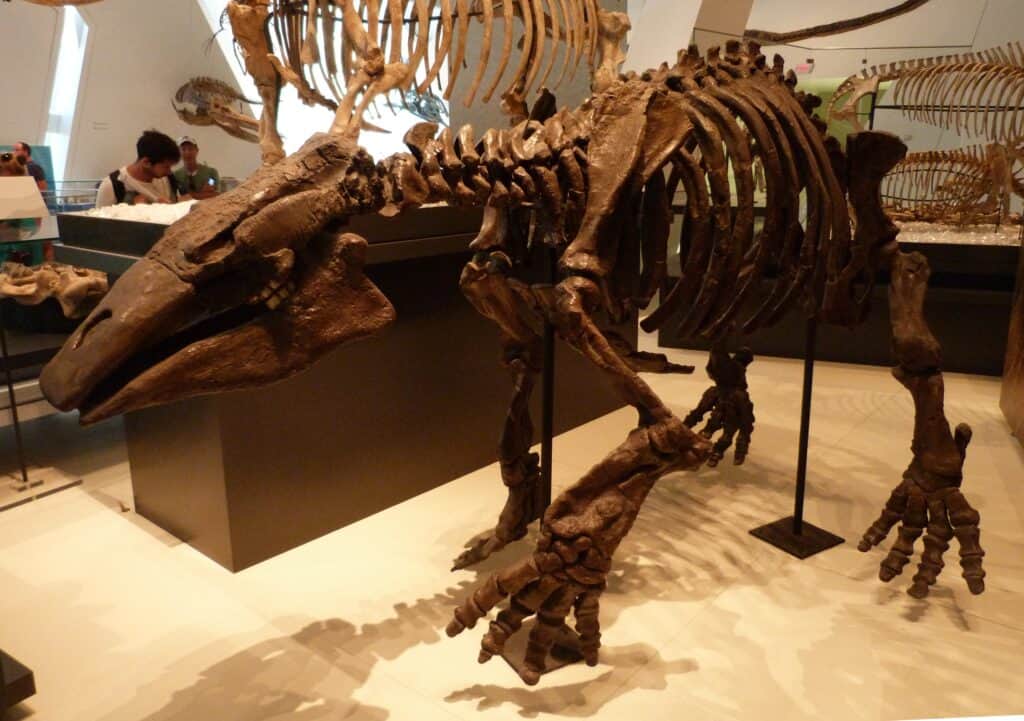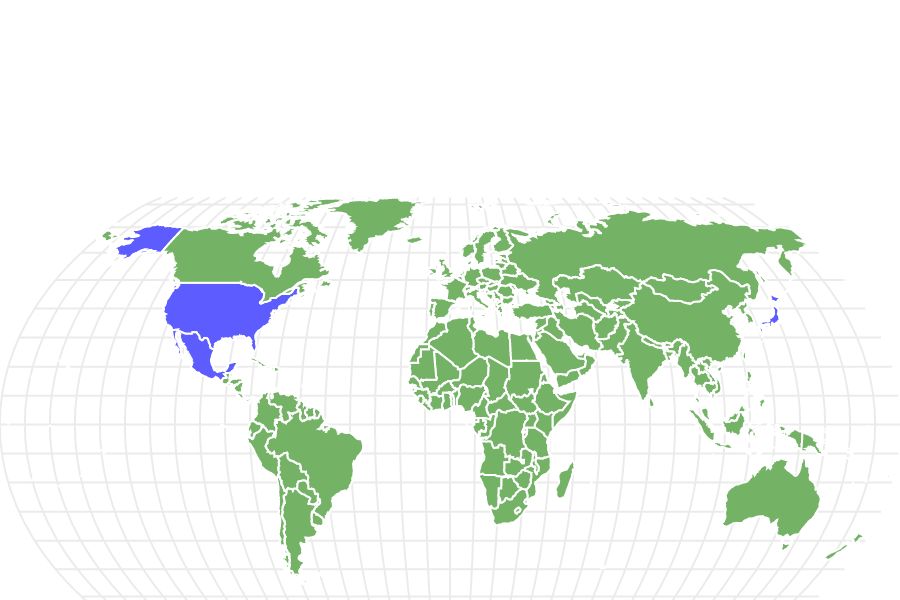Desmostylus has no living descendant.
Advertisement
Desmostylus Scientific Classification
- Kingdom
- Animalia
- Phylum
- Chordata
- Class
- Mammalia
- Order
- Desmostylia
- Family
- Desmostylidae
- Genus
- Desmostylus
- Scientific Name
- Desmostylus japonicus
Read our Complete Guide to Classification of Animals.
Desmostylus Conservation Status
Desmostylus Facts
View all of the Desmostylus images!
Desmostylus is an extinct genus of herbivorous mammals that lived from the Late Oligocene to the Miocene. This massive and heavily built marine creature belongs to the family Desmostylidae. It was a peculiar animal with an interesting appearance and no living descendants. This makes it difficult to trace its lineage or describe many of its habits in detail.
Description & Size

had specialized teeth that allowed it to fed on soft aquatic plants present in its habitat.
©Sandy__R from Scotland, UK / CC BY 2.0 – License
Desmostylus was a genus of herbivorous mammals belonging to the family Desmostylidae. They lived between 28.4 million years ago and 7.3 million years ago along the western Pacific Rim, North America, Asia, and South America. The genus name means “chain pillar,” which refers to the cylindrical arrangement of this animal’s back teeth.
Desmostylus was a large creature with a hippopotamus-like appearance. The largest member of the genus measured about 9 feet in length. It had a height of around 3.5 feet and would weighed around 2,829 pounds. It had a short tail and four powerful legs that ended in hooves.
Desmostylus was a predominantly marine mammal, so it had adaptations that allowed it to spend most of its life in water. For instance, the bones of the lower forelegs were fused together into a rigid appendage. While this might have made walking on land difficult, it would have been great for swimming underwater.
The upper and lower jaws of Desmostylus were elongated and fused to form forward-facing tusks. This shovel-shaped arrangement of the canines and incisors is the same as observed in the Gomphotherium, a prehistoric elephant-like creature that lived during the Neogene period. They also had two additional tusk-like teeth growing down from their upper jaw.
Diet – What Did Desmostylus Eat?
Scientists don’t have a lot of information about Desmostylus‘s habits. However, the prevailing theory is that this prehistoric marine mammal was a herbivore. It fed on soft aquatic plants present in its habitat. Desmostylus‘s specialized teeth would have allowed them to root up these plants for food.
Habitat – When and Where Desmostylus Lived
The fossils of the Desmostylus have been found in various locations, including the Pacific Rim in North America and in various locations across Japan in Asia. This suggests a very wide range for this mammal. Scientists often compare the habits and habitat of this genus to that of the modern-day hippopotamus. However, both mammals most likely had different lifestyles.
The lifestyle of Desmostylus would have been more similar to that of sea lions. Given the low density of Desmostylus‘s bones, they probably spent most of their life in the shallow water of coastal regions (probably less than 100 feet deep). However, there are some discoveries that suggest that they might have lived in freshwater and estuary environments as well. They were active swimmers that would rise to the surface fairly often to feed. This was a deviation from the lifestyle of other members of the same family, that were primarily slow-swimming bottom dwellers.
Threats And Predators
We know very little about the predator species that lived alongside Desmostylus. However, since this mammal was a largely defenseless creature, it may have been the prey of many of the large predators that lived around the same period.
Discoveries and Fossils – Where It Was Found
Desmostylus fossils were discovered in deposits that date back to the Oligocene and Miocene periods. The fossil has been found in various locations, including Japan, the United States, and the West coast of Mexico. Othniel Marsh first discovered fossils of Desmostylus in 1888 in Alameda county, California.
Initial interpretations suggested that the fossils belonged to Sirenians. Later, more fossils were uncovered in Japan, and scientists thought they belonged to some prehistoric elephants or sea cows. Oshiwara & Iwasaki provided the first full description of a species of this genus, the Desmostylus japonicus, in 1902. Their description was based on a well-preserved partial skull fossil.
Extinction – When Did It Die Out?
Desmostylus lived between 28.4 million and 7.25 million years ago. It is unclear why the animal became extinct. However, changes in the Desmostylus‘s habitat indicate why the mammal became extinct. Early on in its life, Desmostylus was a marine creature. It spent most of its time in coastal environments. However, as new mammals like the sirenians (sea cows) came into the picture during the Miocene, Desmostylus was pushed into freshwater ecosystems. This competition most likely contributed to their extinction.
Similar Animals to The Desmostylus
Similar animals to Desmostylus include:
- Kronokotherium: This extinct marine mammal belonged to the same family as Desmostylus. However, it was smaller in size and had a different dentition.
- Gomphotherium: This was a prehistoric elephant-like creature that lived during the Neogene period.
- Sirenia (also known as sea cows): This is an order of herbivorous mammals that live a fully aquatic lifestyle.
Related Animals
View all 110 animals that start with DDesmostylus FAQs (Frequently Asked Questions)
When was Desmostylus alive?
Desmostylus lived during the Oligocene epoch about 28.4 million years ago. It was around for about 21.2 million years and disappeared from fossil records during the Miocene epoch about 7.25 million years ago.
How big was Desmostylus?
Desmostylus was a massive hippo-like creature. It weighed about 2,829 lb. Estimates also suggest that it was about 9 feet in length and was up to 3.5 feet tall.
Where did Desmostylus live?
Desmostylus had a predominantly aquatic lifestyle. The mammal lived in shallow waters in the coastal regions. However, recent studies suggest that it might have spent some time in freshwater and estuary environments as well.
Thank you for reading! Have some feedback for us? Contact the AZ Animals editorial team.
Sources
- Wikipedia, Available here: https://en.wikipedia.org/wiki/Desmostylus
- Berkeley/Introduction to the Desmostylia, Available here: https://ucmp.berkeley.edu/mammal/mesaxonia/desmostylia.html
- Dinopedia, Available here: https://dinopedia.fandom.com/wiki/Desmostylus
- Prehistoric Fauna, Available here: https://prehistoric-fauna.com/Desmostylus-hesperus
















